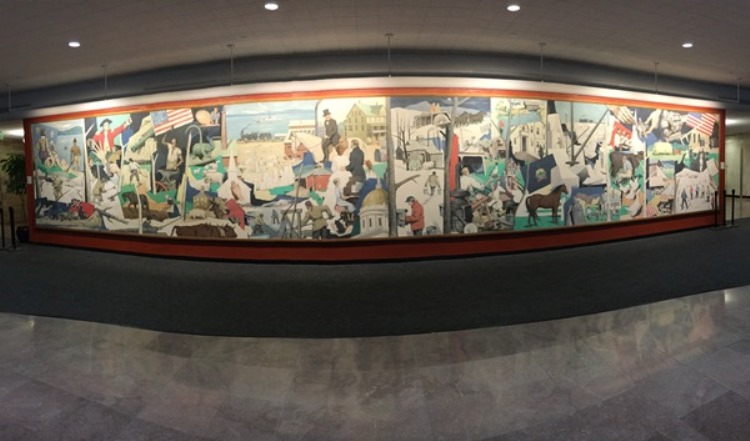Many of us already know that the company announced earlier this week that it is donating the large painting Tribute To Vermont to the Vermont Historical Society. It will be removed by painting conservators this weekend. So today is your last opportunity to see the mural before it moves to downtown Montpelier. The news release announcing the donation is below.
National Life Group and the Vermont Historical Society announced a partnership on Monday that will preserve and protect a significant painting that for 55 years has greeted visitors to the company’s Montpelier headquarters.
The mural, “Tribute to Vermont” by prominent artist and Dartmouth College instructor Paul Sample, was installed in 1961 in the lobby of National Life’s then-new headquarters building in Montpelier.
The massive painting, which measures 50 feet across and eight feet high, depicts three-and-a-half centuries of Vermont history, from Samuel de Champlain’s arrival in the Champlain Valley in 1609 to the development of Vermont’s ski industry in the late 1950s.
Over that time, the painting has begun to show signs of stress due to its installation in a busy office building lobby. Conservators found accumulating dirt and grime on the surface of the painting, small areas of paint loss throughout, and a number of places where it had apparently been bumped into and damaged.
So National Life plans to have the painting removed for long-term conservation. The work has been donated to the Vermont Historical Society, which plans to reinstall it in a redesigned permanent exhibit at its Vermont History Museum in the Pavilion Building in downtown Montpelier.
“We’re honored that the Historical Society shares our appreciation for this major piece of art,” said Mehran Assadi, National Life’s president and CEO. “We’re also pleased that the painting will be displayed for all Vermonters in a climate-controlled environment overseen by curators.”
The Historical Society has already created some concepts for redesigning the Vermont History Museum around Tribute to Vermont, a project that National Life will also support. The mural will be the first display that visitors see upon entering the museum. Thousands of people visit the museum each year, including most Vermont schoolchildren.
“This beautiful painting tells Vermont’s story in a wonderful way,” said Stephen Perkins, Vermont Historical Society executive director. “We are excited to use it as a jumping-off point for conversation about Vermont’s past, present and future. We are honored to preserve it for future generations of Vermonters and Vermont’s visitors.”
Paul Sample, a 1920 graduate of Dartmouth, was the college’s artist-in-residence at the time he was commissioned to paint Tribute to Vermont. He created the mural using Liquitex, a plastic-resin emulsion, on two canvases and then joined them, using a vertical maple tree at the center of the painting to hide the join when it was installed in National Life’s new home office.
Sample chose to depict more than 50 scenes across the painting, including Vermont’s agricultural heritage, its once-dominant machine tool industry, quarrying, and outdoor pursuits. Politics also make an appearance, from Ethan Allen with a raised fist to Vermont’s original and current State Houses.
Sample left behind observations about the various themes he worked into the painting.
“The use of hands became a very strong interest to me in designing this mural,” Sample said of Tribute to Vermont. “You will notice I have repeated the motif of the hands in several places – the upraised hand below Ethan Allen and the hand on the mug, both indicating, perhaps, the tension of that time. Again I used hands in the gesture of prayer in front of the church, in the machine tool scene and, finally, holding the college diploma in the concluding area.”
Emily Phillips of Phillips Conservation has been hired to oversee the removal and reinstallation.
“The mural was adhered to the Sheetrock wall,” she said. “It will be removed by stabilizing the edges of the canvas and slowly, at an acute angle, pulling the canvas away from the wall to break/fracture the adhesive bond. The canvas will be rolled onto a large diameter roller as it is detached to maintain control and safe removal of the painting, working horizontally from left to right. Once removed, work will begin to prepare it for reinstallation in the Pavilion building.”

